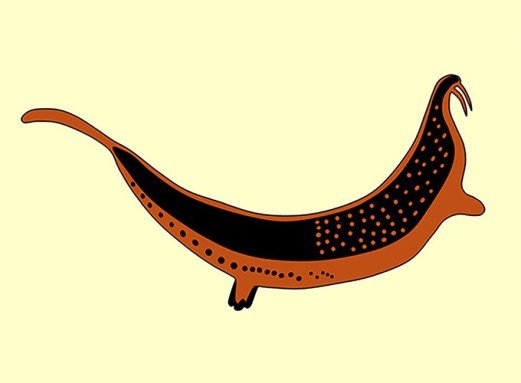African rock art depicting a mythical tusked creature may mirror the look of fossils of real-life ancient mammal relatives called dicynodonts.
Abundant, exposed fossils in South Africa’s Karoo Basin include dicynodont skulls with tusks that curve down and back, like those of the long-bodied animal depicted in roughly 200-year-old rock art by the region’s San hunter-gatherers, says paleontologist Julien Benoit. That painting appears among images drawn on a rock-shelter wall, dubbed the Horned Serpent panel, which include a scene of ethnic warfare known to have occurred as early as 1821, Benoit reports September 18 in PLOS ONE.
San people painted the rock art panel between 1821 and 1835, he estimates.
“The tusked animal painting may represent a rain animal, a fantastic creature linked to San rain-making folklore,” says Benoit, of University of the Witwatersrand, Johannesburg.
-

While the cave art paint has faded, this is what the mythical creature painted on a rock-shelter wall in South Africa looked like. J. Benoit/PLOS ONE 2024 -
This black-and-white drawing reconstructs what a tusked dicynodont may have looked like when it roamed Earth more than 200 million years ago. Marlene Hill Donnelly
San myths describe large animals that once inhabited southern Africa before disappearing. If dicynodont fossils influenced painters of the tusked rock art figure, then that portrayal preceded the first scientific description of dicynodonts in 1845.
Dicynodonts generally lived from around 270 million to nearly 200 million years ago. Researchers have found San stone tools on several eroding outcrops containing dicynodont fossils. Those sites lie within 100 kilometers of the Horned Serpent panel.
Few clues exist about the extent to which Indigenous Africans have collected animal fossils and incorporated them into spiritual beliefs and rock art (SN: 10/5/96).
At Lesotho’s Mokhali Cave, located near preserved dinosaur footprints and fossils, San rock art includes a dinosaur footprint outline and three dinosaur silhouettes. As astute footprint interpreters, San people discerned that these creatures left no handprints or tail drag marks (SN: 6/11/15). Dinosaur silhouettes thus lacked arms and sported short tails, Benoit says.
Read the full article here


